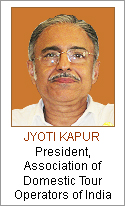Tourism is essential to the country’s economic growth. It has a multiplier effect on the health of the economy, providing employment opportunities both for skilled and unskilled, as well as strengthening national integration and international brotherhood. It rightly supports our Prime Minister’s ideology “Make in India” as tourism encourages entrepreneurship.
 India has fascinated people from across over the world with her secularism and culture. The diversity of Indian culture, cuisine, and customs does provide a unique opportunity to the visitors to have varied experiences. In fact, diversity is synonymous to India. Being birth place of many religions, India attracts faith-bound tourists from all over the world. The enchanting backwaters, breathtaking Himalayas with plenty of flora and fauna, a long coastline and inviting sand dunes make India a vibrant country. Historical monuments, forts, etc., add to the grandeur of the country, attracting domestic as well foreign tourists round the year.
India has fascinated people from across over the world with her secularism and culture. The diversity of Indian culture, cuisine, and customs does provide a unique opportunity to the visitors to have varied experiences. In fact, diversity is synonymous to India. Being birth place of many religions, India attracts faith-bound tourists from all over the world. The enchanting backwaters, breathtaking Himalayas with plenty of flora and fauna, a long coastline and inviting sand dunes make India a vibrant country. Historical monuments, forts, etc., add to the grandeur of the country, attracting domestic as well foreign tourists round the year.
Domestic Tourism, which has presently recorded over one billion visits, is growing at a steadfast pace. Travellers are venturing to “less travelled destinations” contributing to the local exchequer. States are going all out to woo the traveller by showcasing their tourist potential, understanding the long-term benefit of tourism development.
With 29 states, each state desires to brand its product as per its USP, to attract the traveller; however, the need of the hour is to converge the synergy in branding, by creating common parameters i.e. infrastructure, road connectivity, cleanliness and hygiene, safety and security, which is common to all. Brand India is an aggregation of the brands of individual states. The branding objective of each state should align with national branding objective. We all should not strategise in isolation, but have a more integrated approach.
The government’s role is to create the right conditions as tourism is affected by many areas of government responsibility and decision-making like planning, transport, regional development, conservation and environment. Central/state government should support and accord priority to it by declaring it as an industry, and allocate sufficient budget so that the perceptions that the traveller has about Brand India is reflected in reality… infrastructure facilities, cleanliness, safety and security of tourists at destinations on pan India basis. As remarked by Amitabh Kant “political and civic leaders should take ownership of their brand and take it forward.”
The domestic traveller has evolved over the years, and demands offbeat circuits, as well as engaging activities. States need to focus on this demand, which in turn would also help to attract foreign tourists who want to see India beyond the Taj Mahal.
Today India is emerging as most preferred destination for Medical Tourism. We have world-class medical facilities with top class doctors, personalised nursing care, offering specialised treatments at a cost 1/4th that of developed countries. India is the best place to rejuvenate with traditional medical concepts of Ayurveda, Unani and Homeopathy along with complimentary therapies like Yoga, Acupuncture and Aroma assisting in the process of healing.
Tourism being a multi-dimensional activity, and basically a service industry, it is necessary that the Central and state governments, private sector and voluntary organisations become active partners to position India as a brand where perceptions meet reality.
source: http://www.travelbizmonitor.com / TravelBizMonitor.com / Home / Thursday – October 16th, 2014



